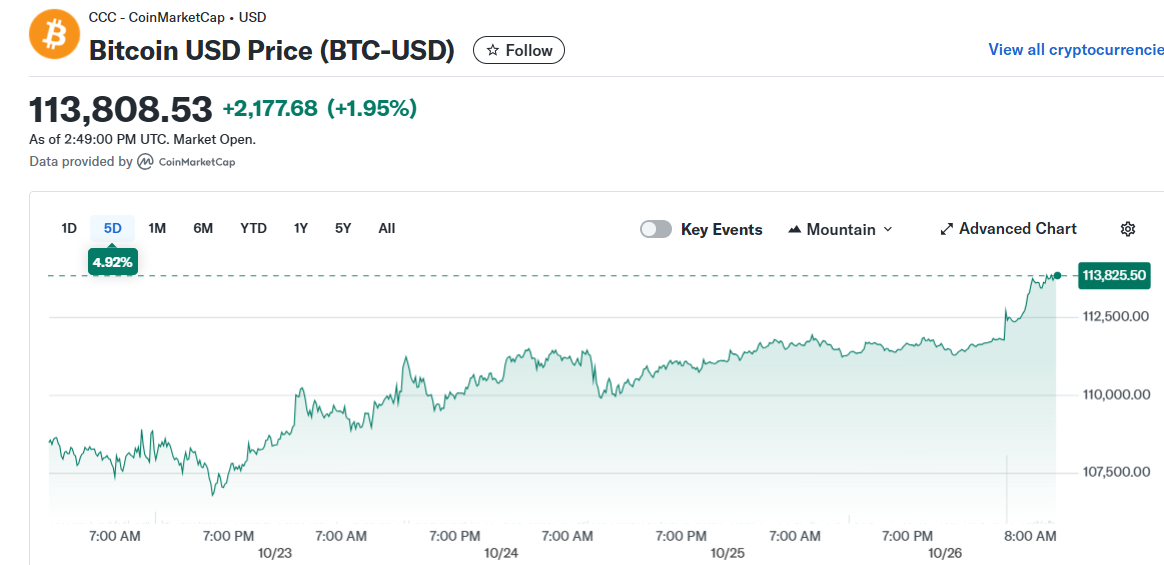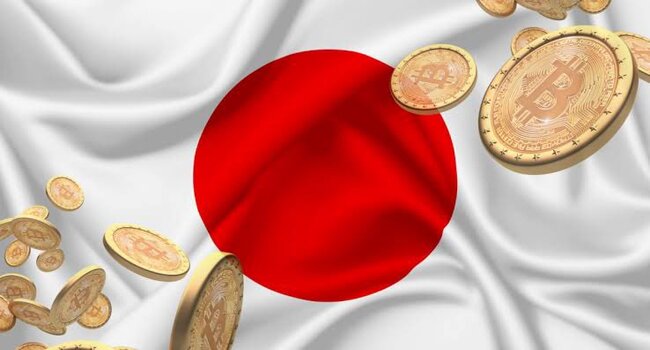The Week Ahead: Fed Rate Cut and Mag 7 Earnings Could Boost Crypto Market
TLDR
- Microsoft reports Q1 FY2026 earnings Wednesday with analysts expecting 11% earnings growth and 38% Azure cloud revenue increase to $23 billion
- Federal Reserve widely expected to cut rates by 25 basis points to 4% on Wednesday, marking 150 basis points of total easing since September 2024
- Bitcoin rose 1.7% to $113,600 while XRP, ether, and solana gained 3% over 24 hours ahead of key economic events
- Fed Chair Powell’s comments on ending quantitative tightening program could boost crypto markets as banking reserves fall below $3 trillion
- Bank of Japan expected to hold rates steady Thursday while Mag 7 tech earnings and Trump-Xi summit add to market volatility factors
Microsoft prepares to release its first quarter fiscal 2026 earnings on Wednesday after market close. Wall Street analysts forecast adjusted earnings of $3.68 per share, representing 11% growth.
Revenue projections point to strong performance across Microsoft’s cloud business. Azure cloud platform revenue is expected to reach $23 billion, a 38% increase from the prior year period. Total company revenue is forecast at $75.5 billion, up 15% year over year.
Analyst feedback suggests results could exceed expectations. Deutsche Bank reported overwhelmingly positive responses from Microsoft customers regarding the company’s competitive position. Citi analysts noted strong demand for Azure from corporate and public sector clients.
Infrastructure spending remains a key focus for investors. Microsoft indicated it would spend $30 billion on data centers and cloud infrastructure in the most recent quarter. Bank of America analysts project full-year capital expenditures of $125 billion, exceeding Wall Street consensus by $10 billion.
The spending figures have direct implications for AI infrastructure suppliers like Nvidia. Earnings reports from Microsoft, Alphabet, Amazon, and Meta this week will provide insight into demand for AI chips and data center equipment.
Fed Rate Decision Takes Center Stage
The Federal Reserve meets Wednesday with markets pricing in near certainty of a 25 basis point rate cut to 4%. CME Fed funds futures indicate another cut likely in December. This would bring total easing to 150 basis points since September 2024.
 Source: Forex Factory
Source: Forex Factory
Fed Chair Jerome Powell’s press conference will lack economic forecasts or rate projections. Market participants will focus on his comments about labor market conditions and inflation expectations. Powell is expected to reiterate concerns about employment risks while characterizing tariff-related inflation as temporary.
The Fed’s quantitative tightening program could face changes soon. Powell recently suggested conditions are approaching the point to end balance sheet runoff. Banking system reserves fell below $3 trillion, a level considered ample for liquidity.
Crypto Markets Show Strength
Bitcoin climbed 1.7% to $113,600 over 24 hours, extending a three-day winning streak. The price action follows seller exhaustion near the 200-day simple moving average at $108,800. The 50-day moving average at $114,250 represents the next resistance level.
 Bitcoin USD Price (BTC-USD)
Bitcoin USD Price (BTC-USD)
XRP gained 3% and moved above its 200-day moving average at $2.60. Ether and solana also posted 3% gains over the same period. The moves came as traders positioned ahead of Fed and Bank of Japan decisions.
The Bank of Japan meets Thursday with expectations for unchanged rates. Markets price in a quarter-point cut by early 2026. Fresh economic forecasts from the central bank could create volatility.
President Trump and Chinese President Xi Jinping meet Thursday in South Korea during the APEC Summit. Both sides issued statements suggesting progress toward a trade agreement. The meeting could influence risk asset sentiment depending on outcomes.
Apple, Meta Platforms, Alphabet, and Microsoft report earnings this week. Investors will examine AI spending trends that have supported market gains since 2023.
The post The Week Ahead: Fed Rate Cut and Mag 7 Earnings Could Boost Crypto Market appeared first on CoinCentral.
You May Also Like

Humans Are the Improbability Drive AI Can’t Copy

JPYC Launches Japan’s First Yen-Denominated Stablecoin to Drive Digital Payment Growth
Highlights: Japan’s JPYC Inc. launches yen-based stablecoin to modernize payments and strengthen its position in digital finance. Analysts predict JPYC will accelerate Japan’s transition toward a fully digital economic ecosystem. The stablecoin seeks to enhance transaction efficiency and support blockchain-based business growth. On October 27, Japanese fintech firm JPYC Inc. officially announced the launch of the country’s first stablecoin pegged to the Japanese yen, JPYC. It marks a small but meaningful step in a country where most consumers still rely on traditional payment methods such as cash and credit cards. The rollout follows approval from Japan’s Financial Services Agency. Growing institutional interest also signals a shift in the country’s long-standing cash-based economy. JPYC is fully backed by yen deposits and Japanese government bonds. It complies with Japan’s Payment Services Act and maintains 100% reserves. The stablecoin is pegged 1:1 to the Japanese yen and operates on major blockchains such as Ethereum, Avalanche, and Polygon. CEO Noritaka Okabe said the company wants to support innovation by offering startups lower transaction and settlement costs. He added that better global connectivity could help everyone and that the company is open to new partnerships. JPYC Inc announced the official launch of its yen-denominated stablecoin, JPYC, along with the release of its dedicated issuance and redemption platform, JPYC EX. The stablecoin is pegged 1:1 to the Japanese yen and fully backed by bank deposits and government bonds. Initial… — Wu Blockchain (@WuBlockchain) October 27, 2025 User Access and Growth Targets The company said users can buy JPYC on the JPYC EX platform after verifying their identity with the My Number card, Japan’s national ID. JPYC Inc. plans to reach 10 trillion yen ($65.4 billion) in circulation within three years. It also aims to add more blockchains and partner with more businesses. For comparison, USDT, the largest stablecoin, has about $183.2 billion in supply. Several Japanese firms plan to integrate JPYC into their operations, the company confirmed. Fintech developer Densan System is creating payment systems for retail and e-commerce platforms featuring JPYC. Meanwhile, Asteria will add JPYC support to its enterprise data integration software, used by more than 10,000 businesses. Additionally, crypto wallet provider HashPort plans to enable JPYC transactions on its platform. With its launch, JPYC becomes the first major stablecoin not tied to the U.S. dollar but backed by a strong economy. This move may change how money flows across Asia. Like U.S. stablecoins that increased Treasury demand, Japan’s version could boost JGB demand and add diversity to the market. The global stablecoin market is now over $286 billion, with nearly all linked to the dollar. Digital Payment Shift in Japan Japan’s use of digital payments has grown, which shows a big shift from cash to electronic payments. JPYC aims to speed up this growth by offering a simple and low-cost digital option. The company will waive transaction fees at first and earn from interest on Japanese government bond holdings. Meanwhile, Japan’s three major banks, Sumitomo Mitsui, Mitsubishi UFJ, and Mizuho, plan to launch a joint yen-based stablecoin system on October 31 for corporate settlements through MUFG’s Progmat platform. Japan’s Major Banks Launch Yen-Backed Stablecoin Partnership Japan’s financial sector is taking significant steps toward integrating cryptocurrency technologies, with three major banks planning to jointly issue a yen-pegged stablecoin. This initiative…… pic.twitter.com/WR99AIb4ah — Crypto Breaking News (@CryptoBreakNews) October 17, 2025 Bank of Japan Deputy Governor Ryozo Himino recently said that stablecoins could become an important part of the global payment system and may partly replace traditional bank deposits. Experts believe yen-backed tokens could grow in use over the next two to three years. They may also play a role in areas like decentralized finance, tokenized assets, and cross-border payments. eToro Platform Best Crypto Exchange Over 90 top cryptos to trade Regulated by top-tier entities User-friendly trading app 30+ million users 9.9 Visit eToro eToro is a multi-asset investment platform. The value of your investments may go up or down. Your capital is at risk. Don’t invest unless you’re prepared to lose all the money you invest. This is a high-risk investment, and you should not expect to be protected if something goes wrong.
